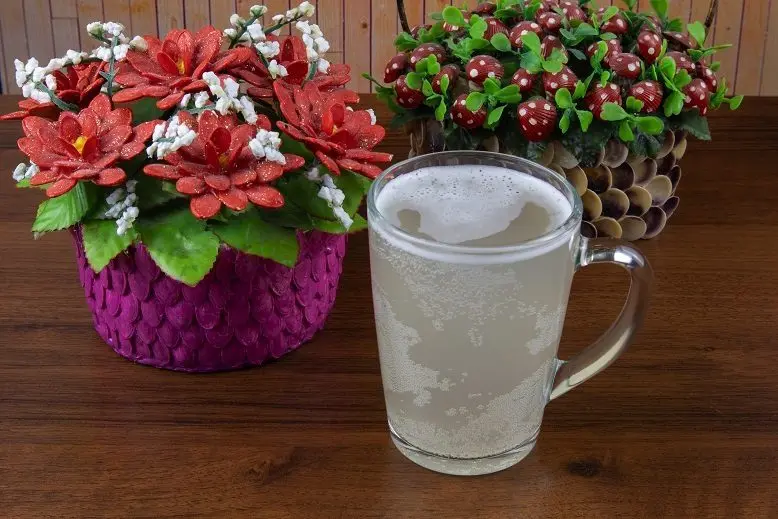Homemade rhubarb kvass is a refreshing summer drink that perfectly replaces harmful store-bought sodas and packaged juices. The taste of kvass can be changed at will by adding mint, freshly squeezed lemon juice or spices. We will consider a universal step-by-step cooking technology.
The juicier the rhubarb, the better. Only fresh plants with a characteristic aroma are needed, plucked, frozen and withered plants are not suitable for a long time.

Ingredients:
- rhubarb stem – 300-350 grams;
- water – 1,5 liters;
- sugar – 50-100 grams;
- unwashed raisins – 10 grams or wine yeast;
- mint – 15 grams fresh or 10 grams dry (optional);
- ground cinnamon – 3-5 grams (optional);
- cloves – 1-2 buds (optional);
- lemon juice – from 1 medium fruit (optional).
The amount of sugar depends on the desired sweetness, at first I advise you to add a minimum of 50 grams, then sweeten the drink to taste before bottling (8th stage). The taste of kvass can be adjusted with mint (it will turn out a refreshing drink), lemon juice (gives a slight sourness) or spices (a more spicy version). I do not recommend using mint and spices (cinnamon with cloves) at the same time, these components interrupt the aroma and taste of each other.
Raisins are needed as a source of wild wine yeast to start fermentation. You can replace raisins with store-bought wine yeast (add according to the instructions on the label for 2 liters of wort) or ordinary dry bakery yeast (2-3 grams based on the proportions in the recipe), but ordinary dry yeast gives a characteristic smell of alcohol, which is undesirable in rhubarb kvass.
Universal recipe for kvass from rhubarb
1. If there is no wine yeast, but you don’t want to add regular yeast, then 3-4 days before preparing kvass, make raisin yeast: put unwashed raisins in a jar, add 100 ml of water and half a teaspoon of sugar. Tie the neck of the jar with gauze, then transfer the container to a dark room at room temperature. When a slight smell of fermentation, foam and hiss appears, the starter is ready.
If mold is observed or there are no signs of fermentation, then the raisins are infected or treated with a strong preservative. We’ll have to start all over again by buying berries of a different variety.
It is possible to add raisins directly to the must after cooling without making a starter, but there is no guarantee that fermentation will start and mold will not appear.
2. Cut well-washed rhubarb stalks into 2-2,5 cm long sticks.
3. Put the rhubarb in a saucepan, add water, bring to a boil over high heat and boil for 5 minutes.
4. Add sugar and spices (optional). Cook for 5 minutes, stirring occasionally and removing foam from the surface.
5. Remove the pan from the stove, strain the hot wort through a fine sieve. Add mint to the liquid part (optional) and cover with a lid. Leave to cool to room temperature, then remove the mint leaves with a slotted spoon.
6. Add squeezed lemon juice (or 5 grams of citric acid), raisin sourdough (wine or ordinary yeast) to the cold wort. Stir, then pour into a fermentation container. Cover the neck with a paper towel.
7. Transfer the must to a dark room with a temperature of 18-28°C and leave to ferment for 10-15 hours (the higher the temperature, the less time is required).
8. Taste the drink. Sweeten with sugar if desired. Pour kvass from rhubarb into bottles (preferably plastic), leaving 4-5 cm of free space to the neck. Close with stoppers.
9. Stand the bottles for 60 minutes at room temperature to saturate with carbon dioxide, then transfer to the refrigerator and leave for 12-20 hours to improve the taste. Kvass is ready!
Attention! Periodically check the bottles for excess pressure, if necessary, bleed excess gas to prevent bursting.
Shelf life – up to 14 days. It is advisable to drink an open bottle a day before.










